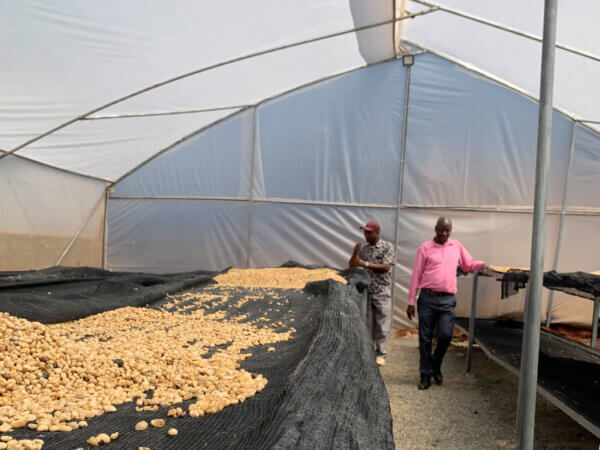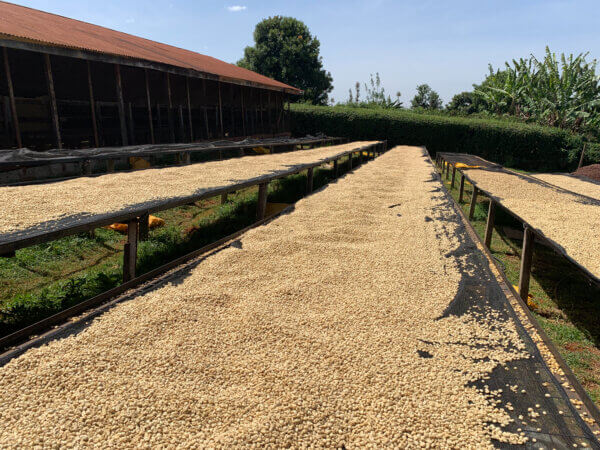On a lengthy buying visit to Kenya by Red Fox Kenya sales lead Drew Fitchette and co-founder Aleco Chigounis, they noticed something new: the appearance of solar dryers, versatile greenhouse-like structures that give the parchment drying process greater control and stability. Talking with the team at Dorman’s and farmers at the factories (cooperative-like mills in Kenya), they found that these were a climate resilience measure that has had a dramatic impact on quality.
Kamwangi, a factory whose outputs were so stunning we sourced it for multiple coasts, is an early adopter of solar dryers—and it shows. Not only is the coffee phenomenal, “Kamwangi were in the top 5 of highest prices for cherry in Kenya paid to producers this past season,” Dorman’s trader Muki Yeung says. “Quality is excellent because the factory is managed so well with regular trainings available to their members.” According to Drew, they pay as much as 20c/lb for coffee cherry above other factories. “That’s why they were able to process so much, and we were able to purchase that volume” he says—because producers in that area who make the cut want to work with them.

The solar dryer was designed and gifted to Kamwangi by Coffee Management Services, a sister company to Dormans, Muki told us. “Before bringing on the solar dryers, all the coffee was dried on raised beds exposed in the morning, covered in the afternoon, then exposed in the evening again,” says Drew.
But how do they work? “Solar dryers operate like a greenhouse,” says Muki. “Using the UV radiation from the sun, the heat dries the coffee, regardless of weather. The temperature and humidity is controlled by ventilation in the ceiling and sides of the structure.”
As much as climate change might be politicized in the US, farmers and traders of top quality coffee have to mitigate the effects of any inconsistencies in the weather. Seasonal highs are higher than they used to be in Kenya and rain is less predictable. Dorman’s, Coffee Management Service, and Kamwangi all noticed that traditional drying strategies were leading to coffee in parchment drying too rapidly and less consistently, sometimes in as little as 4-7 days. “Climate change has made weather hard to predict,” says Muki. “In past years Kenya has received intense rain during harvest, making it difficult to dry coffee and affecting the quality. In some years it can be too hot and dry.”
When coffee dries too fast, it tastes hollow/flat or muted, says Drew. “All of the nice flavors dull and there’s not much sweetness. You lose vibrancy and complexity by over drying/drying too quickly.”
“The solar dryers allow us to control the environment the coffee is drying in, protecting the coffee from excessive heat or moisture,” Muki says. Current drying times are now around 10-14 days, which creates much more vibrant and complex flavor profiles.

There’s the added bonus that “with the stacked bed design, the dryers have also been more efficient than the regular single raised beds that are common in Kenya,” Muki says.
Muki sees this type of climate resilience technology as something that would be beneficial almost anywhere. “This type of technology has been common in South and Central America but very new to many parts of Africa,” she says. “It’s a fantastic method of assisting producers in protecting the quality of their coffee.”
Over the last few years, we’ve seen unpredictable and unfavorable weather patterns affect the coffee supply all over the world, especially in the top tiers of specialty. From drought in Ethiopia to La Niña conditions in Colombia affecting quality and supply in 2021 to Hurricane Maria’s effects on key Oaxaca regions through the present, the climate profoundly affects farmers’ lives and coffee’s quality. Our Kenya partners’ ventures into solar dryers definitely show in the cup as well as in local farmer’s profits.
| Interested in sourcing coffee with us? Reach out at info@redfoxcoffeemerchants.com. To learn more about our work, check out our journal and follow us on Instagram @redfoxcoffeemerchants, Twitter @redfoxcoffee, Spotify, and YouTube. |
